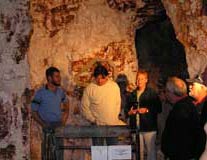
Visitors at underground Motel
The tiny outback town of White Cliffs in far north-west New South Wales can now claim a place in Australia’s engineering history, alongside the Sydney Harbour Bridge and the Snowy Hydro scheme.
The opal mining town, where most of the 200 residents live in underground homes, was the first in Australia to be powered entirely by solar energy, and is still a fully off-grid community.
The solar plant is now closed but it has earned a national award that will see it preserved as a piece of alternative energy heritage.
Resident Bill Hoskins says the mirrored landscape on the edge of White Cliffs makes the locals proud. “It’s something which is on the horizon here that is a bit different from looking at 50,000 dugouts,” he said.
After powering the town for more than two decades, last year the solar dishes were turned off and talk was the plant would be pulled apart.
“There were one or two blokes who said, ‘We should just get one each and take it to our place and put it there’,” Mr Hoskins said.
Now the town has secured the recognition it was hoping for – an Engineers Australia award for its pioneering power plant.
“It’s now an icon which they consider similar in status to Sydney Harbour Bridge, the Parkes radio telescope and the Snowy Mountains scheme,” Mr Hoskins said.
When it was up and running, the solar plant could power up to 30 homes, the local store, the hospital and the post office.
These days in an emergency, it could be fired up again.
But power needs in White Cliffs are modest because most the houses are dug-outs, which are hidden underground, away from the heat of the sun.
Resident Bert Gale says it is an energy-efficient way of keeping cool.
“Living in a cave, look it’s just wonderful, it’s the best eco-house that you could have,” he said.
“I mean the temperature stays a constant 19 to 23 degrees.”
When temperatures in White Cliffs hit 50 degrees in summer, living underground seems like a good idea.